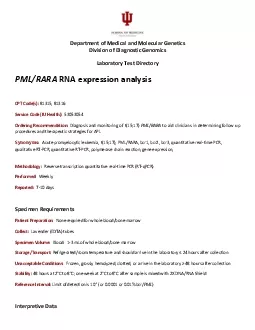

Division of Diagnostic GenomicsLaboratory Test DirectoryPMLRARARNA expressionanalysisCPT Codes81315 81316Service Code IU Health 53053054Ordering RecommendationDiagnosis and monitoring of t1517 PMLR ID: 868640
Download Pdf The PPT/PDF document "Department of Medical and Molecular Gene..." is the property of its rightful owner. Permission is granted to download and print the materials on this web site for personal, non-commercial use only, and to display it on your personal computer provided you do not modify the materials and that you retain all copyright notices contained in the materials. By downloading content from our website, you accept the terms of this agreement.
1 Department of Medical and Molecular Gene
Department of Medical and Molecular Genetics Division of Diagnostic Genomics Laboratory Test Directory PML/RAR A RNA expression analysis CPT Code(s): 813 1 5 , 81316 Service Code (IU Health): 53 053054 Ordering Recommendation : Diagnosis and monitoring of t(15;17) PML / RARA to aid clinicians in determining follow up procedures and therapeutic strategies for APL Synonyms: Acute promyelocytic leukemia, t(15;17), PML/RARA, bcr1, bcr2, bcr3, quantitative real - time PCR, qualitative RT - PCR, quantitative RT - PCR, polymerase chain reaction , gene expression , Methodology: Reverse transcription quantitative r eal - time PCR (RT - q PCR) Performed: W eekly Reported: 7 - 10 days Specimen Requirements Patient Preparation: None required for whole blood /bone marrow Collect: Lavender (EDTA) tubes Specimen Volume: Blood: 1 - 3 mL of whole blood /bone marrow Storage/Transport: Refrigerated/ r oom temperature and should arrive in the laboratory ⤠24 hours after collection Unacceptable Conditions: Frozen , g rossly hemolyzed , clotted , or arrive in the laboratory ⥠48 hours after collection Stability: 48 hours at 2°C to 8°C ; one week at 2°C to 8°C after sample is mixed with 2X DNA/RNA Shield Reference Interval: Limit of detection is 10 - 4 (or 0.0001 or 0.01% bcr/ PML ) Interpretive Data Department of Medical and Molecular Genetics Division of Diagnostic Genomics Characteristics: Acute promyelocytic leukemia (APL) is a subtype of acute myelogenous leukemia (AML) , a malignancy of the bone marrow . APL is characterized by a ccumulation of immature white blood cells (or promyelocytes) in the bone marro w, and decrease d normal platelets, white blood cells, and red blood cells in the body . This may lead to abnormal bruising/bleeding, frequent infections, anemia, fatigue, and pale skin. Other symptoms include bone and joint pain, fever, weight loss, and dec reased appetite. Molecularly, APL is diagnosed by a translocation involving the promyelocytic leukemia ( PML ) gene on chromosome 15 and the retinoic acid receptor alpha ( RAR A ) gene on chromo some 17. The t(15; 17)(q24;q21.1) occurs in ⥠98% of APL. Three fusio n transcript variations, bcr1, bcr2 and bcr3 , are generated as a result of different breakpoint cluster regions (bcr) within the PML gene. The breakpoint
2 on chromosome 17 is always located wit
on chromosome 17 is always located within the second intron of the RARA gene. The bcr1 (~45% to 55%) v ariation results from a break within intro n 6 of the PML gene. The bcr3 ( ~37% to 45% ) variation indicates a breakpoint within intron 3 of the PML gene. The bcr2 (~8% to 10%) variation represents the least common PML breakpoints, demonstrating inconsistent sites within exon 6 of the PML gene and resulting in the fusion of a variable portion of PML exo n 6 with exon 3 of the RARA gene. Cause: The t(15;17)(q24;q21.1) represents � 98% of APL. Translocations involving the RARA gene on chromosome 17 and other partner genes have been recognized in a few cases of APL . Incidence: A PL has an incidence of about 1/250,000. Overall, APL accounts for approximately 10% of cases of AML. Analytical sensitivity and specificity: �99 % Clinical sensitivity and specificity: The t(15;17) (q24;q21.1) represents � 98% of APL. This assay can detect three fusion transcript variants, bcr1, bcr2, and bcr3. Limitations: Translocations involving breakpoints other than bcr1, bcr2, and bcr3 cannot b e detected. Minimal reportable range is 10 - 4 . Although rare, false positive or false negative results may occur. All results should be interpreted in the context of clinical findings, relevant history, and other laboratory data. References: 1. Health condi tions: National Library of Medicine (US). Genetics Home Reference [Internet]. Bethesda (MD): The Library; 2017 Apr 18 . Acute Promyelocytic L eukemia ; [reviewed 2011 Apr ; cited 2017 Apr 20] . Available from: https://ghr.nlm.nih.gov/condition/acute - promyelocytic - leukemia. 2. Gallagher RE, et al. Characterization of Acute Promyelocy tic Leukemia Cases With PML - RARA Break/Fusion Sites in PML Exon 6: Identification of a Subgroup With Decreased In Vitro Responsiveness to All - Trans Retinoic Acid. Blood 1995; 86( 4 ): 1540 - 1547. PMID:7632962. 3. Choppa PC , et al. A Novel Method for the Detection, Quantitation, and Breakpoint Cluster Region Determination of t(15;17) Fusion Transcripts Using a One - Step Real - Time Multiplex RT - PCR. Am J Clin Pathol 2003; 119: 137 - 144. PMID:12520709. 4. De Angelis F and Breccia M. Molecular Monitoring as a Path to Cure Acute Promyelocytic Leukemia . Rare Cancers Ther 2015; 3: 119 - 132. PMID: 27182481.